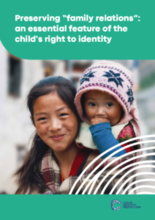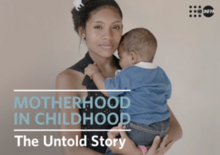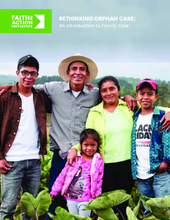Displaying 691 - 700 of 4401
The aim of this publication is to highlight the protective aspects related to the child’s identity rights, with a focus on the family relations element, as embedded in international, regional and national standards. The publication provides direction on how to build identity safeguards, drawing on past lessons and capitalising on current opportunities. To do this, the right to identity is explored through a range of examples of existing challenges, promising practices and testimonies.
This report presents key steps that the international community has taken to protect children in situations of armed conflict, with a specific focus on the Security Council-mandated Monitoring and Reporting Mechanism (MRM) to document grave violations against children and to foster accountability by identifying perpetrators.
This report’s findings on the prevalence of motherhood in childhood across the globe and repeat adolescent childbearing highlight that more needs to be done to design, implement and evaluate programmes that target the youngest starters and girls at risk of rapid and repeat adolescent births.
This report introduces the limitations of orphanages, the importance of caring for children in families, and how to shift support to strengthen families, increase alternative family care options, and empower communities. This resource shares inspiring stories, engaging graphics, and explores tangible examples of work being done around the world to see children cared for in safe and loving families.
This webinar co-hosted with the Changing the Way We Care (CTWWC) initiative is an opportunity to lift up how the Catholic Church is advancing safe and nurturing family care for children around the world.
The Eastern and Southern Africa Regional Learning Platform hosted a webinar on June 22, 2022, featuring speakers from UNICEF's head office and the Better Care Network who provided detailed examples on the importance of data in Uganda's care reform processes. This purpose of this webinar was to examine the importance of using data to inform care reform, and how data can be collected and used effectively.
This webinar focused on the themes and recommendations of the UN Committee on the Rights of the Child’s Day of General Discussion (DGD) about the rights of children and young people in alternative care and the implications for children and adolescents in Scotland.
Join us on 22 June when we will be holding a focused look at the themes and recommendations of the UN Committee on the Rights of the Child’s Day of Discussion about the rights of children and young people in need of care and protection, with our guest speakers including Ann Skelton, Member of the UN Committee on the Rights of the Child, and Bruce Adamson, Scotland’s Children’s Commissioner for Children and Young People.
The Alliance for Child Protection in Humanitarian Action is organizing the 2022 Annual Meeting for Child Protection in Humanitarian Action over a virtual platform from the 20th to 22nd of June. This will include discussions dedicated to the theme of the annual meeting: Promoting the Centrality of Children and their Protection in Humanitarian Action through Accountability, Localisation and Working Across Sectors.



